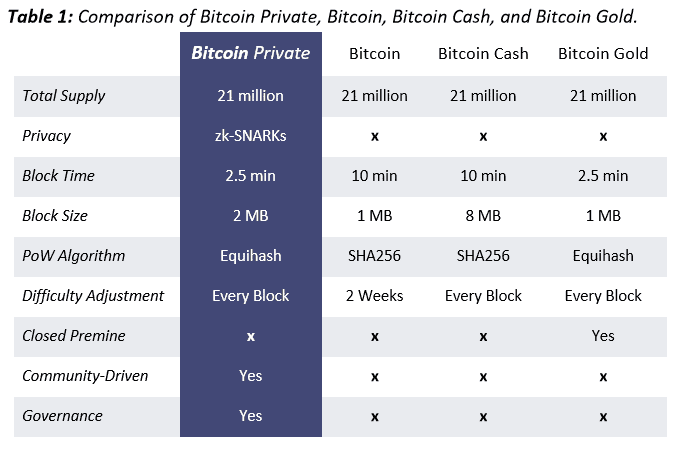Bitcoin Private (BTCP) Review: Everything You Need to Know
Bitcoin Private is a recently created “fork-merge” of ZClassic and Bitcoin that is decentralized, open-source, fast, community-driven, and private.
Bitcoin private was created to give users the ability to spend their coin with complete privacy and all the benefits of blockchain technology. The team behind Bitcoin Private created it as an improvement over both ZClassic and Bitcoin, keeping the weaknesses and failures of both in mind.
While there is a core team leading the Bitcoin Private project, due to the community focus and open source nature of Bitcoin Private it actually has more than 200 contributors at present, and anyone can join the team and make a contribution. In fact, there are 20 developers who joined in the 30 days just prior to the fork-merge.
What is Bitcoin Private?
Bitcoin Private was made faster than Bitcoin, with a block time of just 2.5 minutes, and has a larger block size of 2Mb. In addition, it uses the ASIC resistant Equihash proof-of-work algorithm, which also makes it friendly for home miners using their GPU.
And as I mentioned above, Bitcoin Private is far more community driven than almost any other cryptocurrency project. It’s actually ground-breaking and the first project of its kind, showing the blockchain community just how malleable a UTXO set can be.
The Bitcoin Private snapshot was taken on February 28, 2018 and at that time holders of both Bitcoin (BTC) and ZClassic (ZCL) received Bitcoin Private (BTCP) at a rate of 1:1 or 2 BTCP for every 1 BTC + ZCL held in their wallets.
Here is a chart from the Bitcoin Private team showing the improvements made in Bitcoin Private versus other Bitcoin forks:

Advantages of Bitcoin Private
There are a number of advantages that have been baked into Bitcoin Private, not just in comparison with Bitcoin, but in comparison with other cryptocurrencies in general. Of course the biggest benefit is the privacy created in Bitcoin Private, which comes from the same zk-snarks technology that was used for ZClassic and its predecessor ZCash.
Using the zk-snarks technology any payments get published to the blockchain for transparency, but the transactional metadata that would identify the sender and recipient remain unreadable.
The decentralized nature of Bitcoin Private provides an additional advantage, just as it always has with Bitcoin itself. The decentralization allows support for peer-to-peer transactions, ridding users for the need of an intermediary to transactions, as the network nodes provide validation for all transactions via cryptography and then record them to the public blockchain ledger.
Bitcoin Private has improved on Bitcoin however. It has a larger block size, and is faster than Bitcoin while still providing anonymity to users, as well as better security than other Bitcoin based cryptocurrencies.
If all that isn’t enough, Bitcoin Private was built as an open-source community driven project, with the full source code of the project always available and viewable by anyone at all. The community includes team members from across the globe, with a variety of different skill sets. This allows people from diverse backgrounds to contribute to the project in a way that best suits their knowledge, skills and training.
Finally, Bitcoin Private starts off fair, without a founder’s reward or pre-mine as was included in the original ZCash. Instead, coins are distributed fairly on a 1:1 basis for those who hold ZCL and BTC. That said, there has been some controversy surrounding this airdrop.
The Bitcoin Private Hard Fork
A hard fork is when an existing cryptocurrency has its blockchain split off into a new blockchain. All the previous entries are kept, but once the split occurs the new blockchain is a separate entity.
The mechanism for this is usually a change to the code in the blockchain. Bitcoin Private is a unique case, as it was created by a merge-fork in which Bitcoin and ZClassic were co-forked to create the brand new Bitcoin Private.

The fork occurred on February 28, 2018. A snapshot of all existing Bitcoin and ZClassic holdings was taken, and the newly created Bitcoin Private was distributed in a 1:1 airdrop. For example, if you held 0.5 BTC and 100 ZCL at the time of the snapshot you would have received 100.5 BTCP.
Some users have complained that the airdrop heavily favored existing Bitcoin and ZClassic whales, with 20.3 million of the eventual 21 million coins being distributed in the airdrop. This, some say, is hardly decentralized.
Bitcoin Private Price Trend
Bitcoin Private saw its price soar immediately following the airdrop, trading as high as $86.20 within a week of the main net going live on March 3, 2018. From there the price declined as it got caught up in the overall bearish trend in cryptocurrencies and it reached a low of $14.53 in early April 2018.
Since then it has seen a surge higher, and is trading above $56 as this is being written on April 23, 2018. The price momentum is currently strongly higher, and if the strength in the altcoin market continues there’s no telling how high the price could go. It is currently the #24 coin by market cap on Coinmarketcap.com.
Bitcoin Private Wallets
There are a few alternatives for storing your Bitcoin Private. The first is a full-node wallet that works with Windows, Linux and Mac OS. There is also an Electrum wallet for each of the previously mentioned operating systems. For greater security you could create a paper wallet to store your Bitcoin Private, and there is an iOS version of the Coinomi wallet currently in development.
How to Claim Bitcoin Private
As you’ll see when visiting the official Bitcoin Private.
“Warning : We have received many reports of scam sites asking for seeds, private keys, or claiming to be our official wallet. You should never input your private key to any website. BTCPRIVATE.ORG is the only official website for our community.."
By this time I imagine nearly everyone has already claimed their Bitcoin Private, but if you haven’t it’s still possible. Claiming your BTCP will depend on which wallet you choose to use. No matter which wallet you do choose to use, the Bitcoin Private team recommends moving your Bitcoin and ZClassic to a new address before claiming your BTCP coins for security reasons.
Full Node Wallets
You can download the full node wallet from GitHub here. Note that you will need the latest version of Java before you begin. Instructions for claiming your BTCP with the full node wallet can be found here.
Electrum Wallets
You can download the Electrum wallet on GitHub here.
If you have an Electrum wallet, you should unzip and then run the Electrum executable. From there, create a new wallet. Enter “wallet,” then “private keys,” and finally “sweep.” Enter your private keys, then sweep the BTCP into your new address.
Mining Bitcoin Private
If you’re interested in mining you should know that it is possible to mine Bitcoin Private at home using your computer GPU. There’s even an official BTCP mining pool you can join that is run by the developers. There are also several other pools available to join.
Some are sponsors of the BTCP project, while others have already been verified by the BTCP developers and are known to pay, while still others are unverified and are not recommended. You can find the list of available pools on the Bitcoinprivate.org website.
In Conclusion
Bitcoin Private is a cryptocurrency like any other, but since it is a fork-merge of Bitcoin and ZClassic it has some desirable features that make it superior to many other cryptocurrencies, such as the privacy and community focus of the coin.
If you were fortunate enough to have both Bitcoin and ZClassic in your wallet when the hard fork occurred you are able to claim Bitcoin Private as an airdropped coin. The project remains completely decentralized and transparent, with a large community of developers and the ability to easily see the source code for the project.
And because BTCP was designed to be ASIC resistant it is an excellent coin for home miners, especially given the upward trend in its price.
Disclaimer: These are the writer’s opinions and should not be considered investment advice. Readers should do their own research.
